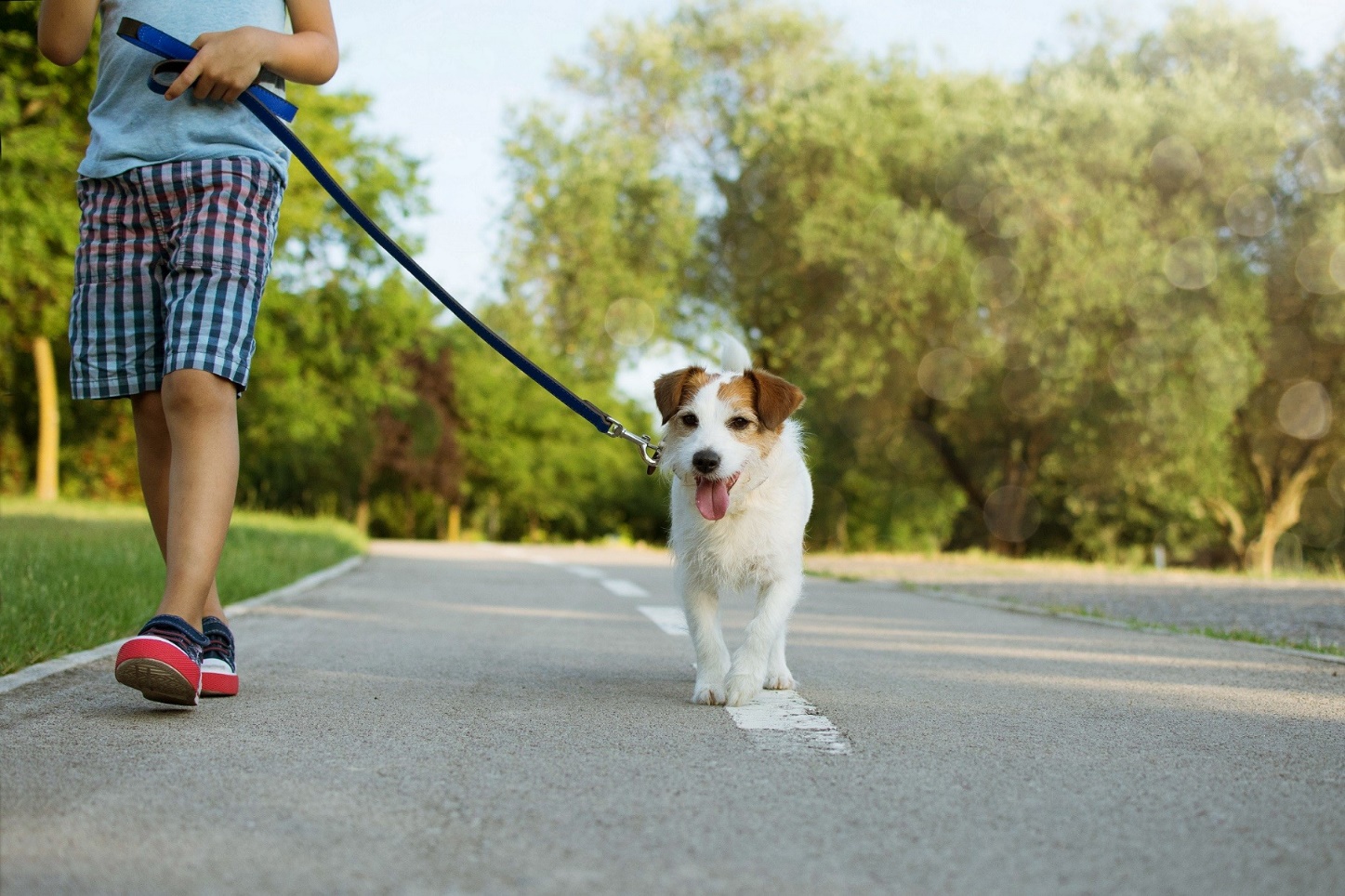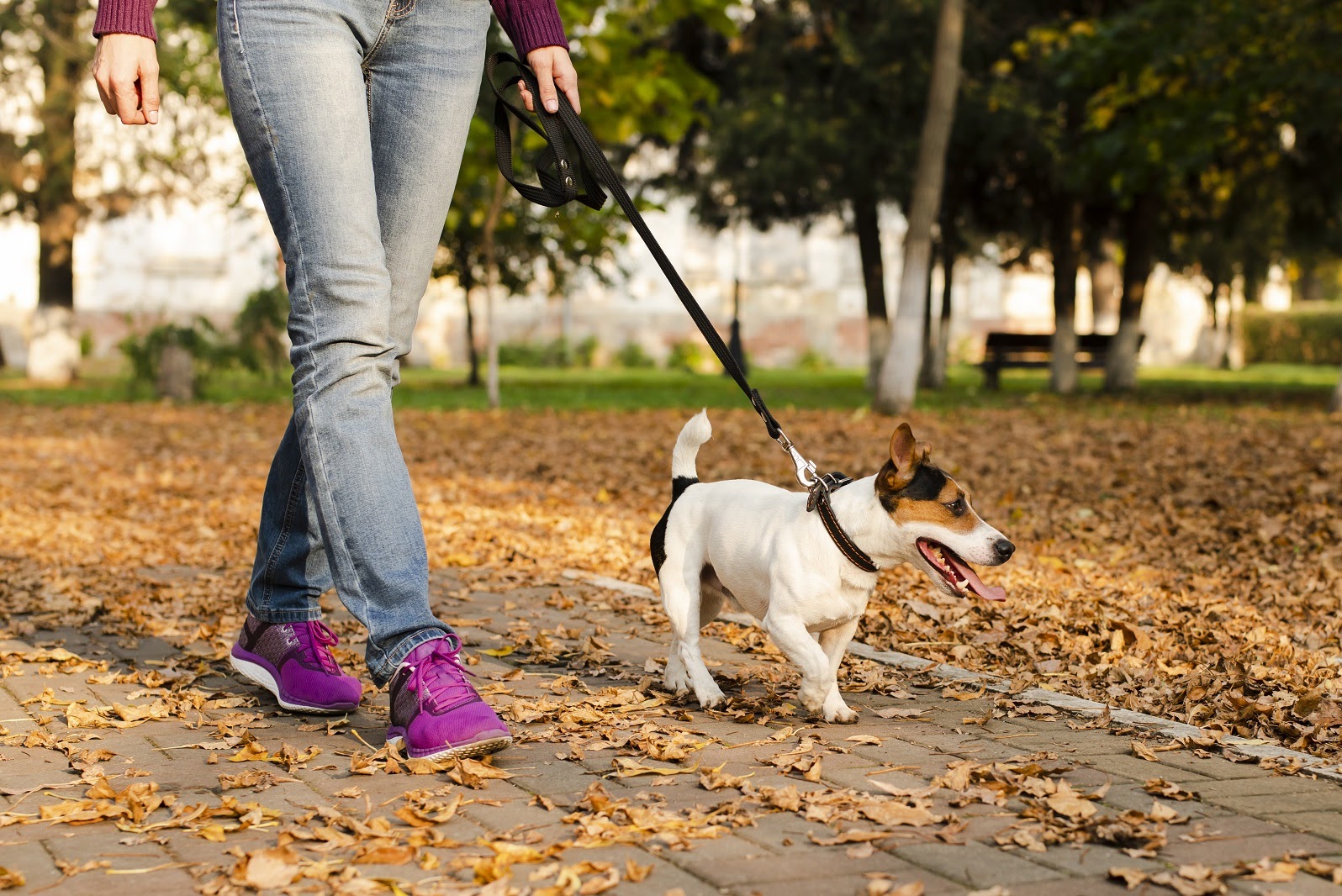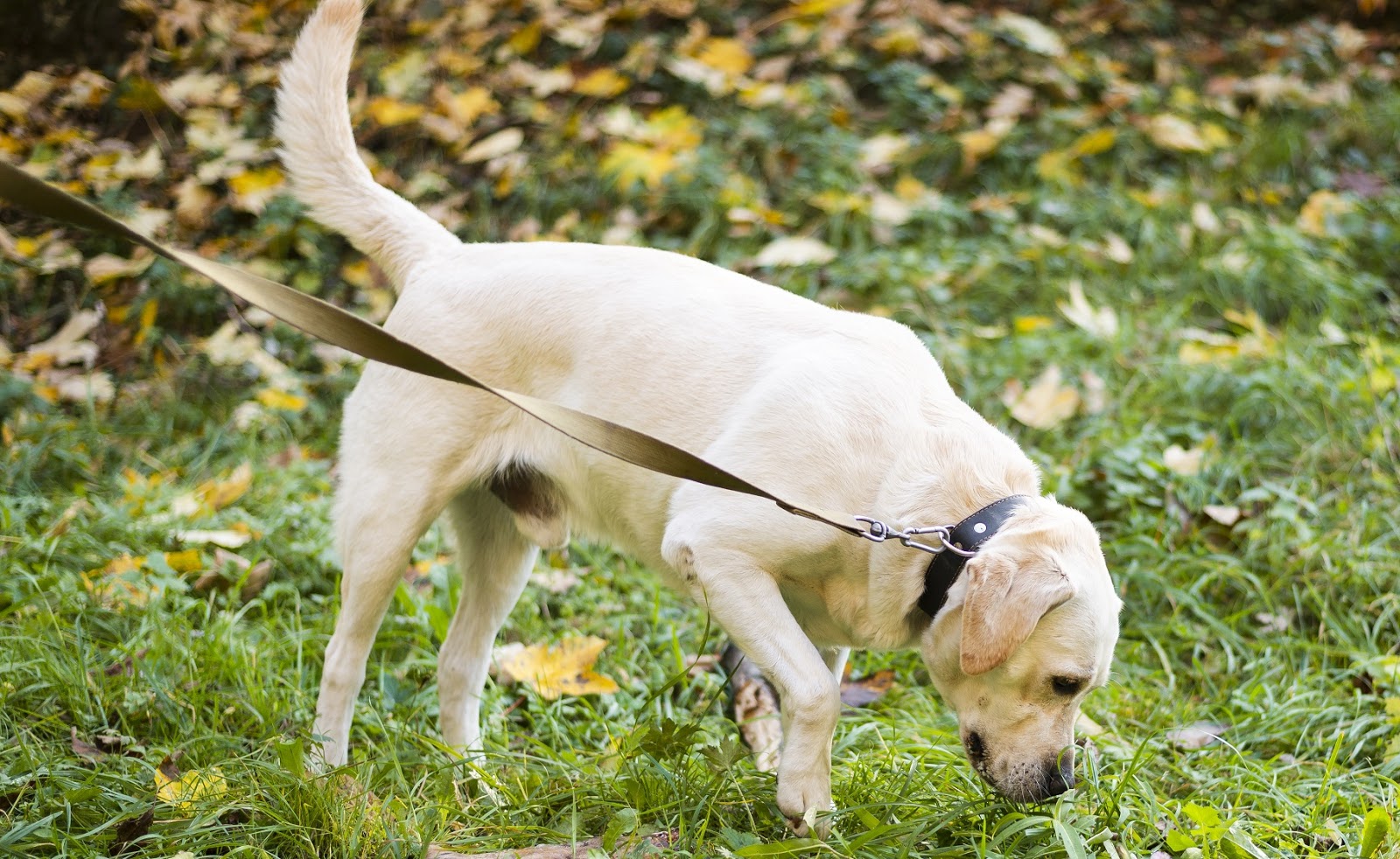Loose lead walking or sometimes referred to as relaxed lead walking, are ways in which to label the physical process of a handler walking with a dog attached by a lead and the lead having slack to it. Ideally the slack should form a U or J shape between the human holding the lead and the dog who is tethered. This is often a very difficult behaviour to teach a dog, as naturally a dog would want to travel in the direction it chooses and without physical restraint. To successfully train the loose lead walking a person requires patience, good training mechanics and understanding of their pupil.

How to train a do to walk on a leash?
Reinforcement based training is extremely effective to teach a dog that when it is on a leash, the most rewarding behaviours to offer involve moving with the handler by their side. When working on lead training it’s important to remember reinforcement can be in the form of something the dog wishes to acquire or something it is trying to escape. Working ethically with your dog would involve selecting an appropriate positive reinforcer i.e. “something the animal wants more of” Burch & Bailey (2001), which when present after a behaviour makes the behaviour more likely to reoccur. Appleby (2010) discusses how dogs can be reinforced by numerous things, depending upon their needs at that point in time. This is always a vital point to consider when working with your dog and very important in training leash pulling.
The correct type of equipment for the individual should be selected to ensure the dog is not seeking to escape discomfort or pain whilst on lead and during training leash. Unsuitable and ill-fitting equipment (such as collars, harnesses etc) can cause both physical and mental trauma. Selecting walking kit will require research and measuring of the dog. These are required to ensure the equipment being used is correctly fitted, comfortable and allows the dog to move in a natural manner. I advise to teach your dog that wearing the equipment is a pleasurable experience, by training your dog to put the equipment on in a calm and enjoyable manner.
Training Mechanics – dog pulling on lead
Before embarking on teaching our dogs to walk on a loose lead we should have already established a marker, to provide our learner feedback to signal when they have demonstrated a desired behaviour. Useful markers to use can be a specific word or a mechanical clicker. When using a word, I advise to choose a positive word such as “yes”, especially as this is not normally a word we would use when communicating with our dogs.
The reinforcer should be something the dog desires and appropriate for the situation. When teaching loose lead walking initially I use tiny pieces of easily consumed moist morsels of smelly food and then utilise functional reinforcement in the form of the dog sniffing, choosing direction of movement.
Train a dog to walk on a leash – Reinforcers
- Need to be what your dog finds rewarding, not what we think it is!
- Tiny tasty food morsels are often desirable, as neat and easy to deliver with precision.
- Form a hierarchy of possible rewards for your dog.
- Utilise verbal praise, as a neutral stimulus which over time in the process should become a conditioned reinforcer.
- Touch should be carefully considered, as can often be not as well received by our dog as we think.
Mark desired behaviours and swiftly deliver reinforcement i.e. treat delivered by hand to dog’s mouth.

BEWARE of something being an accidental aversive! Our body language, tone of voice, physical restraint could all potentially have a negative effect. It is important to ensure we do not place our learner under too much stress, by planning appropriately timed training sessions loose lead in a safe, comfortable environment. Remember during the session dog training leash provide your leaner an option to opt out, allow them time to decompress through free access to perform natural behaviours such as sniffing and free movement.
Teaching loose leas walking
The follow me exercise is an excellent foundation behaviour for progression to loose lead walking. This exercise is designed to teach your dog that you are reinforcing, valuable to be around and interesting. My definition of the Follow Me goal behaviour is be observant of my body and its movement, if I walk, physically shadow my locomotion, to have the opportunity to obtain reinforcement. The follow me exercise is part of the Essential Foundation Behaviours course you can enrol on through the Tromplo training platform.
How to successfully achieve loose lead walking
GOAL BEHAVIOUR – dog to walk comfortably alongside handlers left leg with natural movement and no tension present on the lead. The lead will look to be hanging in a U or J shape between the dog and human.
Equipment
Calm, comfortable dog
Suitable flat collar/balance harness and lead
High value treats reserved for outside only – palatable and easy to ingest i.e. liver paste
(Please note have the treats in your pocket or a pouch on the side you would like the dog to walk on, for easy access and correct delivery)
Clicker
Dog training leash pulling – Method
After achieving fluent marking and desirable treat delivery to the dogs mouth at its head level, you can then look to place your dog in its suitable harness or collar (if appropriate) and attach to an appropriate lead. Make sure you have mastered your technique first, as you can’t teach the dog if you are not confident in what you should be doing. I advise the lead length to be at least 1 metre long to ensure suitable slack without risk of getting tangled and causing injury. Please to avoid injury, please carefully consider the size and build of the individual when selecting equipment, for example leads should be lighter for a smaller dog, to avoid injury.
Hold the lead in you right hand with it safely attached to the dog. Ensure the lead is held securely without pressure being placed onto it. Then hold the clicker in your right hand (in a comfortable position to click) and hold this hand onto your belly button (this is where it is to stay). By doing this your core strength will help prevent you from getting a sprain and it provides a fixed point to try to help prevent any opposition tension on the lead by the handler. Guide the dog to your left side using a food lure in the left hand and have the lead across your body forming a U or J shape.
Training a dog to walk on a leash
Stand and mark and feed the dog for being by your left leg. Ensure reinforcement is delivered in the goal position. If your dog moves out of position, lure it back to the location, mark and feed there. Ensure lots of reinforcement is received in this position, by feeding multiple times after marking and with rapid repetitions to avoid the dog moving out of position.
The dog has begun to learn that the physical position of being by your leg (left side in this example) results in reinforcement, once fluent, you can now look to add some movement into the behaviour. Start to slightly step the left leg forward, as your dog moves towards the left leg mark and feed. If there is any tension on the lead stop, and lure the dog into the desired movement, mark and reinforce when achieved.
Repeat this until every time you move forward with your left leg, the dog follows. Once your dog starts to understand what this is about and connects following you and walking by your side is an excellent thing, then you can slowly start delaying the click and reward for position. Gradually increase the number of steps between marking and reinforcing the dog in the chosen position. Remember you are wanting the dog to walk on a loose lead, so ensure you mark the movement. If you have latency of behaviour or mistakes, then go back. You may have started to increase the number of steps too quickly causing the learner to become confused as to why they are no longer being marked and reinforced.

Training – stop dog from pulling on leash
When it is clear you dog understands to walk by your side with you on a lead with no tension, you can start to differ the movement through changing direction and then looking at varying pace. I always like to set my learner up for success by letting them know we are going to be doing something, as when they are walking naturally they may not be looking at me. I simply call their name before changing direction. Once the behaviour of giving you attention and changing direction whilst maintaining a loose lead has been achieved you could start to add a cue. A general cue for change in direction could be “this way” with a clear body orientation in desired direction. A similar process would be used for change of pace with separate sues for an increase in pace to that of a decrease of speed.
If anytime the dog pulls away from you – STOP! Give them a moment, they might need some time out. When they are ready then use your left hand lure the dog back into position and mark and reinforce when it does.
As you progress the training with your dog, utilise functional reinforcers such as your dog walking on a loose lead to an area it is interested in investigating and allowing it to choose direction of movement. For me loose lead walking is about going for an enjoyable walk TOGETHER and this means allowing the dog to choose our route and pace sometimes.
Please remember to keep expectations realistic!
Start off training a leash an environment the dog is most relaxed and comfortable in, usually the home. Once you have fluency in the goal behaviour in this area you can then start to practise the exercise in a new slightly more stimulating setting, such as the garden. Once you have started to see some generalisation forming, you can then successfully re-teach the process in more challenging locations.
When venturing outside initially go for a short distance, at quiet times to set your dog up to succeed. Ensuring you have plenty of time, so you do not become frustrated and stressed.
Make sure YOU are in the correct mindset before the training walk. If not, abort and do it another time. Your behaviour will have a huge effect on your dogs, so try to remain calm and patient.
Be realistic, try to do a training walk once a day and if it’s suitable to do more, great! If not, no worries. The training sessions should be enjoyable for all involved to help build motivation and to establish a positive association. You can find professional courses and trainers at animal training platform https://tromplo.com/
Performance Reviev – train a dog to walk on a leash
If problems arise in a training session it is important to consider and review all factors such as motivation and mood state of dog and handler, to allow for accurate examination and resolution. Early and regular evaluation of sessions is paramount to improve a training plan, as this allows for errors to be identified and resolved, alongside the enhancement of effective methods.
Leave a Reply